Pinlock Gets A Competitor
WeeTect is a new name in anti-fog visor inserts for motorcycle helmets.
But WeeTect Inc. isn’t new; the company has been in business since 1993.
They manufacture all sorts of eye and face protection products including visors and face shields for motorcycle helmets, safety helmets and more.
The company also makes plastic sheeting and WeeTect even makes auto-darkening welding helmets and plastic mirrors.
And since 2005, WeeTect has been the sole source for pilot visors for the Chinese government.
In the Fall of 2015, WeeTect expanded its anti-fog visor insert manufacturing capability to enter the retail and original equipment (OE) markets for these products.
WeeTect sent us a few of their new anti-fog visor inserts, which are unique because they meet many of the CE, ISO and ASTM standards for optical, mechanical, physical and thermal specifications (see chart below).
The inserts are relatively easy to install and they are designed to be used without the face shield “pins” necessary to locate the Pinlock type.
WeeTect anti-fog inserts may be available to end users also but the details regarding distribution and retail have yet to be determined.
Nevertheless, this is an interesting product that is definitely of interest, so a “Quick Look” is in order.
By the way, webBikeWorld has been reporting on photochromic and electrochromic visors and anti-fog face shields and inserts for motorcycle helmets since 2005.
You can read all of our motorcycle visor reviews, anti-fog treatment reviews and more here.
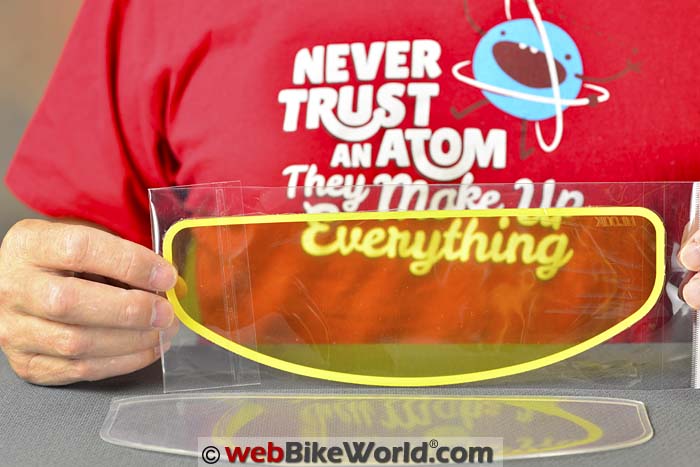
Where to Buy WeeTect Anti-Fog Visor
Check Reviews & Prices on AmazonSee More: Motorcycle Visor, Motorcycle Helmets, Motorcycle Intercom
WeeTect vs. Pinlock
Back in 2005, we reviewed the original Pinlock anti-fog visor insert after it was introduced to the U.S. at what was then the Dealer Expo in Indianapolis.
Also in 2005, we published a review of the Fog City and Progrip anti-fog visor inserts, which are still being made but have spotty distribution and no technical specifications that I could find.
Pinlock took another approach by working with OE motorcycle helmet face shield manufacturers to offer the Pinlock insert with motorcycle helmets as either standard or optional equipment.
The most significant difference between the Pinlock insert and the WeeTect insert is that the former has to be located on the “pins” that have to be installed on the helmet face shield or visor.
This allows a very accurate placement of the Pinlock insert but it’s really not possible for an owner to install the locating pins on a non-Pinlock-ready face shield.
The WeeTect anti-fog visor insert could probably be installed by an owner, although apparently WeeTect would rather go the OE route also because installing a stick-on insert can be tricky.
In fact, WeeTect barely mentions what is the most commonly known anti-fog visor insert — Pinlock.
But it seems obvious that the WeeTect insert could be a strong competitor, especially if they can conquer both the OE and end user distribution channels.
Surely, there’s a market for high-quality anti-fog visor inserts that can be installed by individuals. Pinlock has apparently moved to an OE-only distribution system over the years — a strategy that has its pros and cons.
But this wasn’t always the case, as we described in our original review.
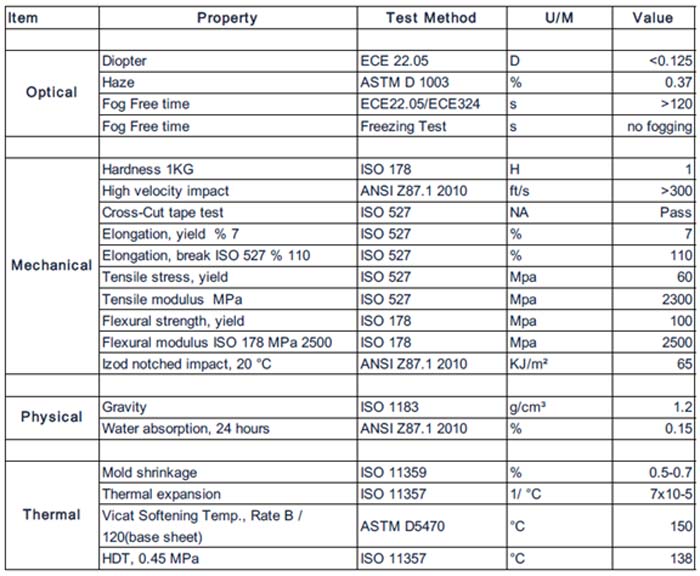
WeeTect Anti-Fog Visor Insert Specifics
The WeeTect insert uses something the company calls its “WeeTect Anti Fog Film” in its anti-fog visors and face shields for motorcycle riding, safety helmets and other uses.
The WeeTect Anti Fog Film is a nano-coated polycarbonate or polyester film that also has anti-scratch properties, according to WeeTect.
WeeTect states that the inserts are tested to a variety of different international standards, as shown in the above chart.
This adherence to standards has paid off, because the WeeTect anti-fog visor inserts they sent have outstanding optical qualities, illustrated in the following photo:
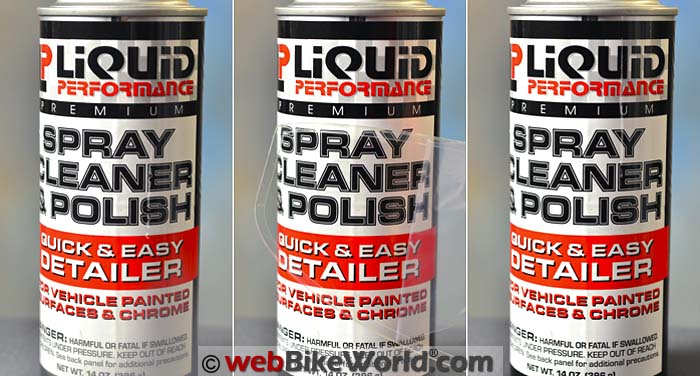
In the photo series above, the photo on the left is the “control”, taken with nothing between the camera lens and the spray can.
The photo in the center has a portion of the WeeTect insert visible and the photo on the right was taken with the WeeTect insert completely covering the lens.
It almost seems like the text on the can is clearer in the photo with the WeeTect insert than without!
Totally unscientific, obviously, but hopefully this illustrates what Burn and I have experienced in the real world, riding with the WeeTect insert installed on a helmet face shield.
Where to Buy WeeTect Anti-Fog Visor
Check Reviews & Prices on AmazonSee More: Motorcycle Visor, Motorcycle Helmets, Motorcycle Intercom
Installing the WeeTect Insert
The WeeTect anti-fog insert can be installed by the owner, but at this point it’s not completely certain whether WeeTect will retail the inserts directly to the end user or not (although they indicated they would).
There were no installation instructions included with the samples we received, but the process is relatively straightforward.
I would suggest to WeeTect that they place the insert on a large clear backing that could be used as a template for locating on the inside of a motorcycle helmet face shield.
The clear backing should have a center line printed on it and perhaps some vertical and horizontal hash marks to allow the end user to align the insert correctly on the inside of the face shield.
Our samples have only a clear backing on both sides of the insert, only big enough to cover and protect the insert itself.
We had to basically “eyeball” the correct location to install the insert, but actually, it landed close to center.
Indeed, a few millimeters one way or the other probably won’t make much of a difference once the helmet is on and you’re looking through the face shield anyway.
The advantage of the WeeTect “stick and go” system is that the face shield doesn’t need pins to locate the insert.
Instead, the insert has a flexible border with some type of glue that measures about 3 mm wide and about 1 mm thick.
When the insert is installed, it must completely seal around the edge, because part of the anti-fog performance comes from the thin air space between the insert and the face shield.
Obviously, the face shield must be perfectly clean also.
To install the WeeTect insert, peel off the inside backing that covers the glued surround on the insert, then bend the insert carefully and carefully locate it on the back of the perfectly clean face shield.
The insert can be difficult or at least tricky to install on a normal face shield but it can be done with care. You pretty much have only one shot at getting it right, because the glue is designed for one application only.
We also tried installing an insert on a face shield with compound curves and found it to be a very difficult procedure for the end user.
So it would be better in that case to have the face shield manufacturer install the insert at the factory.
Installation Thoughts and Notes
Something else that WeeTect might include in an owner installation package is instructions on the acceptable types of cleaners for the face shield prior to insert installation.
Also, perhaps they might even include some type of appropriate chemical cleanser with the kit.
Burn and I discussed how best to clean the face shield and we decided to first wash it with dishwashing soap and water, then we wiped it with a non-lint towel and let it dry.
We did try household 91% isopropyl alcohol to degrease the back of the face shield but we discovered that alcohol can affect the polycarbonate and/or the coating on some face shields, so it’s best not to use that method.
Which brings up another issue we had. Most of the motorcycle helmet face shields sold today have some sort of anti-fog coating already installed at the manufacturer.
I have a collection of over 20 helmet face shields here, gathered over the years, but I could only find one — the short double face shield shown in the video below — that apparently had no anti-fog coating at all.
This made it difficult to illustrate the anti-fog properties of the WeeTect insert, as you can also see in the photos and video below.
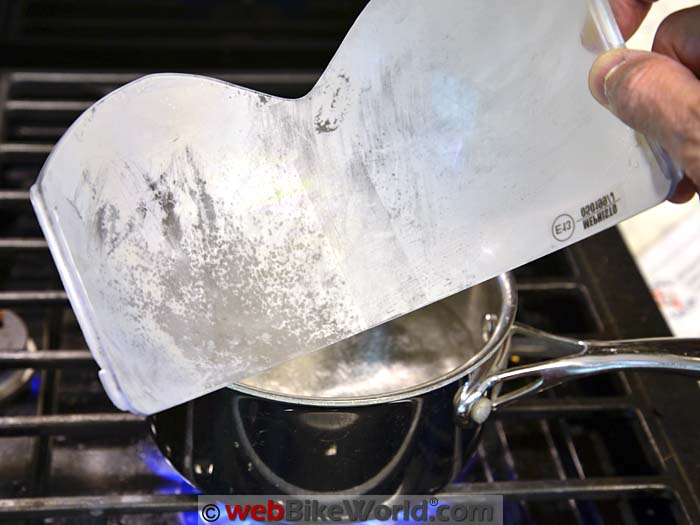
Where to Buy WeeTect Anti-Fog Visor
Check Reviews & Prices on AmazonSee More: Motorcycle Visor, Motorcycle Helmets, Motorcycle Intercom
Performance
To work properly, any anti-fog visor insert must seal completely, perfectly and 100% around the perimeter of the insert.
Otherwise, moisture will quickly find its way between the insert and the face shield and you’ll actually have more trouble cleaning the face shield than if the insert wasn’t in place.
Again, this is one of the reasons why it might be best for the face shield manufacturer to install the insert at the factory.
That said, we were able to get the WeeTect insert installed without too much trouble, at least on a fairly standard face shield with no compound curvature.
The glue on the clear insert wasn’t as sticky as the glue on the yellow insert sample we had for some reason, so we only had a one-shot chance at getting it right.
But once installed correctly, the WeeTect insert absolutely prevented any fogging, even under the extreme “tea pot” test with boiling water creating steam.
Since it’s now summer and the outside temperatures are around 31-32 C (88-90 F), it’s not possible to evaluate the on-road anti-fogging performance of the WeeTect insert.
But based on the tea pot results, we’d expect no issues with visor fogging and the WeeTect insert has outstanding optical qualities, so we noticed not problems at all there.
Also, the narrow and translucent edging is barely noticeable in the rider’s vision, especially compared to other types of anti-fog insert systems we’ve tried.
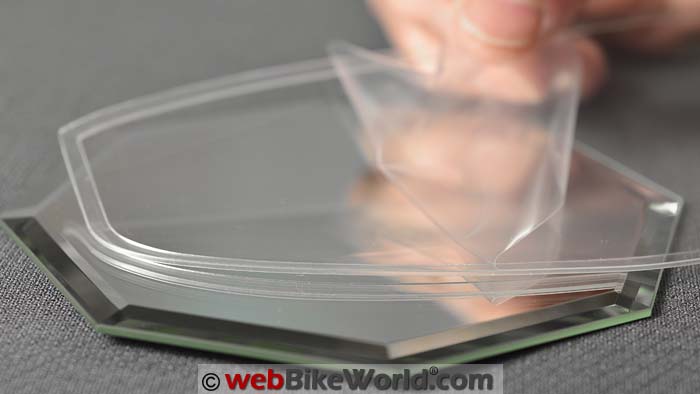
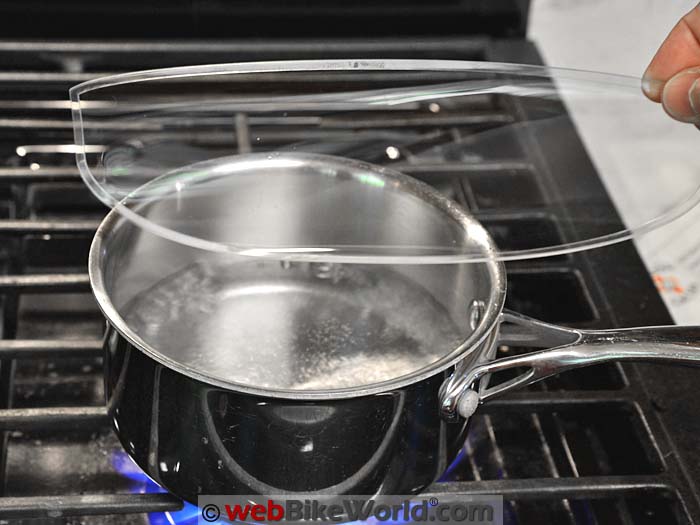
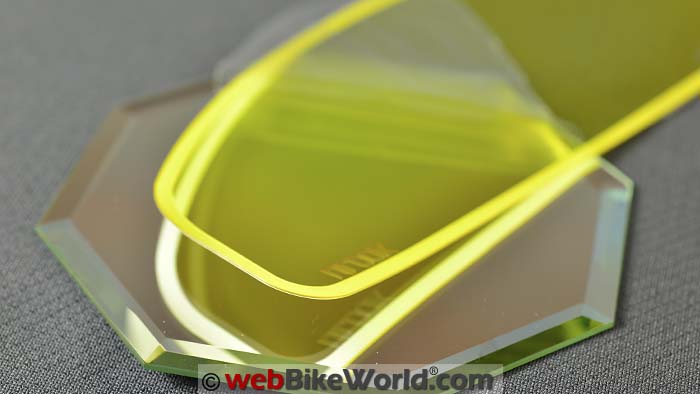
Conclusion
The WeeTect anti-fog visor insert has many possibilities.
At this point in time, only preliminary information is available and WeeTect has not announced pricing, other than to say that it will be significantly lower than a Pinlock insert.
Motorcycle helmet and face shield manufacturers are encouraged to contact WeeTect about OE applications.
WeeTect said they can manufacture the inserts in different sizes and shapes to fit any face shield type.
Also, WeeTect told us that they hope to also have a consumer version ready for sale on several worldwide Amazon.com websites this Fall.
We’ll post more information here as it becomes available.
Where to Buy WeeTect Anti-Fog Visor
Check Reviews & Prices on AmazonSee More: Motorcycle Visor, Motorcycle Helmets, Motorcycle Intercom
Owner Comments and Feedback
See details on submitting comments.
Correspondence From WeeTect (August 2016): “WeeTect responded to a few of the points in this review:
Q: WeeTect anti-fog inserts may be available to end users also but the details regarding distribution and retail have yet to be determined.
A: We are going to focus on OE markets and on line sales in Amazon on the first step. Then, go for distribution and retail.
We are open for distribution and retail after season III, so any distributor or retailer could contact us now. The earlier they approach us, the more early bird benefits they can get.
Q: The WeeTect anti-fog visor insert could probably be installed by an owner, although apparently WeeTect would rather go the OE route also because installing a stick-on insert can be tricky.
A: Our final target is that every owner can easily install the visor insert. We are going to offer clear user manual soon. And we are also doing some improvements on DIY installation method.
Q: There were no installation instructions included with the samples we received, but the process is relatively straightforward.
A: We are going to offer installation guideline very soon.
Q: The clear backing should have a center line printed on it and perhaps some vertical and horizontal hash marks to allow the end user to align the insert correctly on the inside of the face shield.
Our samples have only a clear backing on both sides of the insert, only big enough to cover and protect the insert itself.
A: This is a great idea!
Q: The insert can be difficult or at least tricky to install on a normal face shield but it can be done with care. You pretty much have only one shot at getting it right, because the glue is designed for one application only.
A: Our target is to offer multiple chances for the first installation. We will use more sticky glue just like on the yellow one.
Q: We also tried installing an insert on a face shield with compound curves and found it to be a very difficult procedure for the end user.
A: That’s another point we need to do improvement in the future. We are considering offering upgrade version with thicker anti-fog film. It will be easier for compound curves.
Q: Something else that WeeTect might include in an owner installation package is instructions on the acceptable types of cleaners for the face shield prior to insert installation. Also, perhaps they might even include some type of appropriate chemical cleanser with the kit.
A: We will consider it carefully. Maybe an option for full kit in the future.
Q: Burn and I discussed how best to clean the face shield and we decided to first wash it with dishwashing soap and water, then we wiped it with a non-lint towel and let it dry.
We did try household 91% isopropyl alcohol to degrease the back of the face shield but we discovered that alcohol can affect the polycarbonate and/or the coating on some face shields, so it’s best not to use that method.
A: We are going to offer a cleaning method later.
Q: Which brings up another issue we had. Most of the motorcycle helmet face shields sold today have some sort of anti-fog coating already installed at the manufacturer.
I have a collection of over 20 helmet face shields here, gathered over the years, but I could only find one — the short double face shield shown in the video below — that apparently had no anti-fog coating at all.
This made it difficult to illustrate the anti-fog properties of the WeeTect insert, as you can also see in the photos and video below.
A: it is true that most of the visors or face shields have anti-fog coating. However, many anti-fog coatings decay very soon. After a few months, the end users will suffer fogging problems.
WeeTect Anti-fog Visor Insert offers a good option for users to eliminate their foggy problems of their visors with or without pins.
Q: The glue on the clear insert wasn’t as sticky as the glue on the yellow insert sample we had for some reason, so we only had a one-shot chance at getting it right.
A: We are going to use sticky glue. So you should have multiple chances at getting it right.
Q: How do you test the anti-fog capability at the factory, do you have plain untreated clear polycarbonate face shields to use?
A: The key point for this anti-fog visor insert is the anti-fog performance of anti-fog film. So, we will test the anti-fog film’s performance before cut into visor insert. Then, we will do inspection on the neatly assembly for the glue.
From “C.Z.” (August 2016): “Have you had a chance to try the visor during nighttime riding?
I’m interested to know if it generates a similar amount of glare from oncoming car lights or other light sources as the Pinlock system?”
Rick’s Reply: There is still some double vision, as there will probably always be with an insert that has an air space between it and the face shield.
Unless they come up with some anti-reflective coating or something, which would probably add quite a bit to the cost.

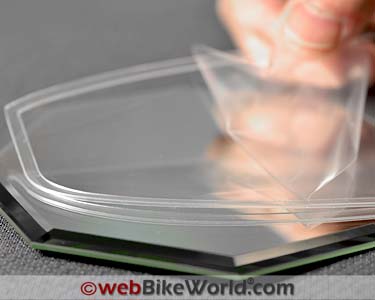

No Comment